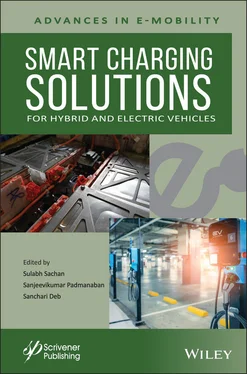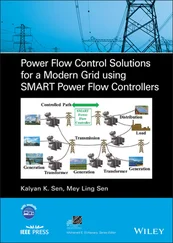Smart Charging Solutions for Hybrid and Electric Vehicles
Здесь есть возможность читать онлайн «Smart Charging Solutions for Hybrid and Electric Vehicles» — ознакомительный отрывок электронной книги совершенно бесплатно, а после прочтения отрывка купить полную версию. В некоторых случаях можно слушать аудио, скачать через торрент в формате fb2 и присутствует краткое содержание. Жанр: unrecognised, на английском языке. Описание произведения, (предисловие) а так же отзывы посетителей доступны на портале библиотеки ЛибКат.
- Название:Smart Charging Solutions for Hybrid and Electric Vehicles
- Автор:
- Жанр:
- Год:неизвестен
- ISBN:нет данных
- Рейтинг книги:4 / 5. Голосов: 1
-
Избранное:Добавить в избранное
- Отзывы:
-
Ваша оценка:
- 80
- 1
- 2
- 3
- 4
- 5
Smart Charging Solutions for Hybrid and Electric Vehicles: краткое содержание, описание и аннотация
Предлагаем к чтению аннотацию, описание, краткое содержание или предисловие (зависит от того, что написал сам автор книги «Smart Charging Solutions for Hybrid and Electric Vehicles»). Если вы не нашли необходимую информацию о книге — напишите в комментариях, мы постараемся отыскать её.
The most comprehensive and up-to-date study of smart charging solutions for hybrid and electric vehicles for engineers, scientists, students, and other professionals. Smart Charging Solutions for Hybrid and Electric Vehicles:
Smart Charging Solutions for Hybrid and Electric Vehicles — читать онлайн ознакомительный отрывок
Ниже представлен текст книги, разбитый по страницам. Система сохранения места последней прочитанной страницы, позволяет с удобством читать онлайн бесплатно книгу «Smart Charging Solutions for Hybrid and Electric Vehicles», без необходимости каждый раз заново искать на чём Вы остановились. Поставьте закладку, и сможете в любой момент перейти на страницу, на которой закончили чтение.
Интервал:
Закладка:
Printed in the USA
10 9 8 7 6 5 4 3 2 1
Preface
Future energy resources entirely depend on locally available renewable resources due to the fossil fuel supply’s uncertainty, growing mobility demand, and increasingly stringent regulations. Furthermore, fuel consumption and emissions are facilitating the transition to sustainable transportation. The market for Electric Vehicles (EVs) has been increasing steadily over the past few years throughout the world. With the increasing popularity of EVs, a competitive market between charging stations (CSS) to attract more EVs is expected. This edited book’s outcome is intended to serve as a resource for engineers, researchers, and practitioners interested in getting acquainted with smart charging for Electric Vehicle technologies. It includes seventeen original chapters dealing with state-of-the-art studies on EV smart charging, along with charging infrastructure.
In Chapter 1, Bikash Sah and Praveen Kumar present a comprehensive review of smart charging’s role and impacts. They also describe charging, followed by the categorization of smart charging and the smart charging system’s requirements and components.
In Chapter 2, Michela Longo, Wahiba Yaïci, and Dario Zaninelli analyze a detailed examination of the distribution grid’s evolution, a thorough analysis of electric mobility, and a survey of the state-of-the-art charging infrastructure for electric vehicles.
In Chapter 3, Chandana Sasidharan and Shweta Kalia describe charging strategies based on vehicle type. They also represent different charging strategies against four objectives: peak management, green charging, flexibility resources, and cost optimization.
In Chapter 4, Ahad Abessi, Vahid Safari, and Mohammad Shadnam Zarbil present a dynamic charging pricing model. Also, pricing models of discharging power to the grid are discussed, followed by some of the charging pricing currently used globally.
In Chapter 5, Andres Alfonso Rodriguez, Luis Perdomo, Ameena Al-sumaiti, Francisco Santamaria, and Sergio Rivera present a charge strategy for charging electric vehicles in office buildings using automatic learning algorithms offering benefits to its implementation.
In Chapter 6, Jerzy R. Szymanski and Marta Zurek-Mortkal present the different charging strategies and EV battery model. They also perform a case study of charging high-power Li-ion batteries for electric work machines.
In Chapter 7, Jerzy R. Szymanski and Marta Zurek-Mortka describe a hybrid EV fast charging station’s structure to integrate with the industrial power grid.
In Chapter 8, Rajkumar Viral and Divya Asija present a theoretical regulatory framework for smart charging EVs and HVs.
In Chapter 9, Aashish Kumar Bohre, Partha Sarathee Bhowmik, and Baseem Khan present an actual case study for efficient charging infrastructure planning with renewable sources, supporting EVs’ adoption as an efficient alternative for transportation.
In Chapter 10, Lokesh Kumar presents a real-time price-competitive market structure based on game theory for EV charging stations considering various practical parameters, including wait time and reputation function.
In Chapter 11, Ubaid Rehman presents a Super-Conducting–Magnetic Energy Storing (SME’S) System to regulate the system’s voltages during charging of an EV. This enhances battery life and increases the EVs charging efficiency in the smart grid (SG).
In Chapter 12, Lokesh Kumar presents an actual case study for a novel intelligent route planning framework for an electric vehicle with consideration to waiting time.
In Chapter 13, Nadia Adnan, Sharina Md Nordin, and Shouvik Sanyal present intelligent charging management for autonomous vehicles. They also describe a brilliant solution for smart cities and societies.
In Chapter 14, Sanchari Deb, Sulabh Sachan, Mohammad Saad Alam, and Samir M Sharif present a comprehensive review of an EV integrated virtual power plant (VPP).
In Chapter 15, Sanchari Deb and Sulabh Sachan present the single objective modeling of EV charging station placement problems regarding superimposition of roads and a distribution network.
In Chapter 16, D. R. Karthik, Mallikarjunareddy Bandi, Naveenkumar Marati, Balraj Vaithilingam, and Kathirvel Karuppazhagi present a review on recent trends and technologies of electric vehicles and their wireless charging methods.
In Chapter 17, Satendra Kumar Singh Kushwaha, Satyprakash, Akhilesh Kumar Gupta, Akbar Ahmad, Bandi Mallikarjuna Reddy, and Narendra Kumar Ch discuss techno-economic issues of grid-connected large photovoltaic plants of the smart City Prayagraj to the EV Charging Station.
We hope that this edited book includes a broad collection of state-of-the-art studies on the theme. Readers are expected to find these chapters inspiring and helpful while carrying out their research in the subject domain.
Acknowledgments
The editors would like to thank all the authors who have made their valuable contributions to this edited book. We also thank all the reviewers who have generously spared their time in reviewing the chapter manuscripts. Our sincere thanks go to the Scrivener Publishing and John Wiley Publication and staff for their cooperation and continuous support throughout this edited book’s production process.
– Editors
1
Smart Charging: An Outlook Towards its Role and Impacts, Enablers, Markets, and the Global Energy System
Bikash Sah* and Praveen Kumar
Department of Electronics and Electrical Engineering, Indian Institute of Technology Guwahati, Guwahati, Assam, India
Abstract
The push for transport electrification has increased worldwide due to growing concerns about carbon emissions by conventional fossil fuel based vehicles. With the push of transport electrification, the exiting power systems utility grid is also evolving. Electric vehicles (EVs) are becoming popular and gaining the market share in due course of time. The increase in EVs demands more power to charge which results in a significant impact on the utility grid. Dependency on renewable energy sources and the use of local energy storage has increased. Inculcating the incremental addition of EVs and the integration of renewables and local energy storage requires overhauling the planning, monitoring, operation, and maintenance of the power system and its components. Smart charging is an EV charging technique that focusses on reducing the impact of increased power demand and helps in the integration of renewables and local energy storage. Smart charging adds flexibility in the operation of power system components with added functionalities that give augmented monitoring and control to EV users and the power system operator. The goals of smart charging are set to unleash coherency between transport electrification, low-carbon emission generation, and utilization of electricity. This chapter will define the context of “smart” with respect to “smart charging”, present an outlook towards its role and impacts on the utility grid and connected entities, and describe the enablers of smart charging, markets, and the operation of the global energy system.
Keywords: Energy system, smart charging, role, market
1.1 Introduction to Smart Charging
Organizations worldwide are working to ensure the usage of low carbon generating entities meet day-to-day requirements such as power generation and transportation [1, 2]. The use of renewables has helped meet the target in the case of power generation. At the same time, a paradigm shift in the transportation sector with the introduction of electric vehicles (EVs) is evident. This paradigm shift rolled out challenges to the existing power systems due to an increase in the demand for electricity to charge, the use of EVs as distributed energy storage, and regulating the power quality. Smart charging techniques for EVs emerge as a solution to meet the challenges [3].
Читать дальшеИнтервал:
Закладка:
Похожие книги на «Smart Charging Solutions for Hybrid and Electric Vehicles»
Представляем Вашему вниманию похожие книги на «Smart Charging Solutions for Hybrid and Electric Vehicles» списком для выбора. Мы отобрали схожую по названию и смыслу литературу в надежде предоставить читателям больше вариантов отыскать новые, интересные, ещё непрочитанные произведения.
Обсуждение, отзывы о книге «Smart Charging Solutions for Hybrid and Electric Vehicles» и просто собственные мнения читателей. Оставьте ваши комментарии, напишите, что Вы думаете о произведении, его смысле или главных героях. Укажите что конкретно понравилось, а что нет, и почему Вы так считаете.












